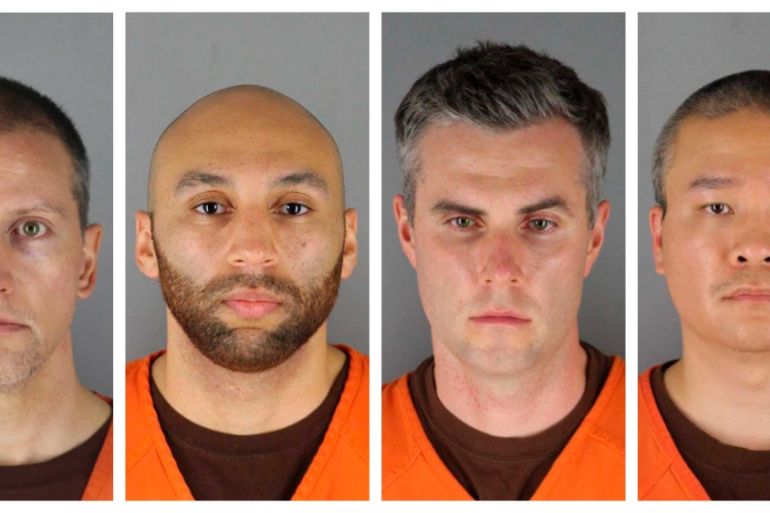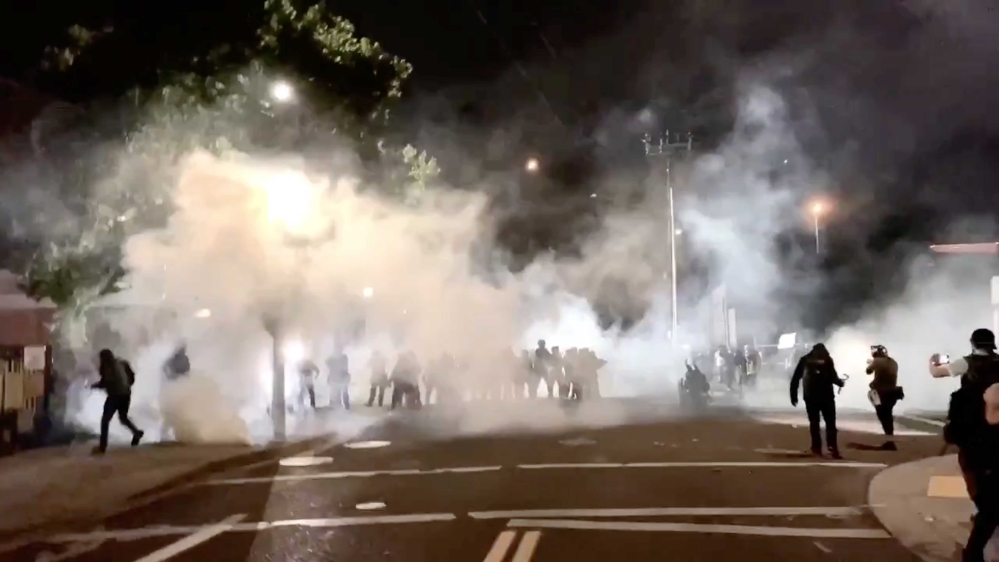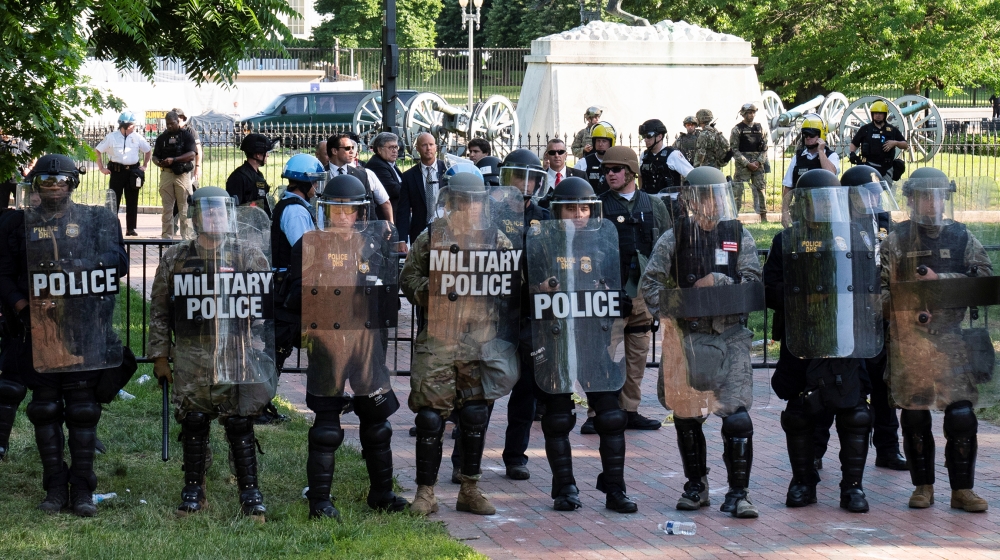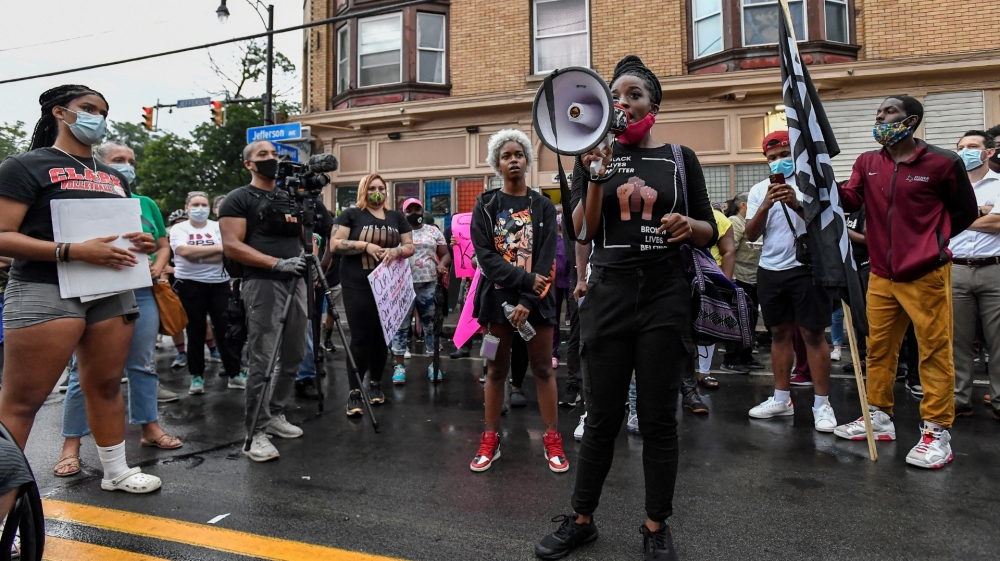George Floyd trial: Lawyers allege Floyd ‘danger to community’
Lawyers for the four police are taking a ‘blame the victim’ approach, which experts say can be effective in trial.

A lawyer for one of the four former Minneapolis officers charged in George Floyd’s death is highlighting the latter’s past crimes and history of drug use, calling him an ex-con and “evident danger to the community”.
Another is seizing on Floyd’s medical issues and addiction, saying he likely died from fentanyl, not a knee on his neck.
Keep reading
list of 4 itemsFormer US police officer sentenced in killing of Black man Elijah McClain
US paramedics found guilty in 2019 death of Black man Elijah McClain
Angela Davis: ‘Palestine is a moral litmus test for the world’
Some court filings by defence lawyers in recent months are taking a blame-the-victim approach. It is a common defence strategy that legal experts say will be used to show officers acted reasonably, and to counter widely seen bystander video showing a white police officer kneeling on Floyd’s neck for nearly eight minutes.
‘Feeding stereotypes’
Experts say the strategy may resonate with a potential jury pool, even if much of what is said now never comes up at a trial set for next year.
Don Lewis, a prominent Twin Cities lawyer who is not connected to this case, said it is usual for defence lawyers to “feed the stereotype of the dangers of a Black man” to a jury to show that any use of force by law enforcement is justified. He said only one or two jurors need to have doubts.
Floyd, a Black man who was in handcuffs, died on May 25 after Derek Chauvin pressed his knee against Floyd’s neck as Floyd said he could not breathe, called out for his mother and became motionless.
Chauvin is charged with second-degree murder, third-degree murder and manslaughter.

Thomas Lane, J Kueng and Tou Thao are charged with aiding and abetting both second-degree murder and manslaughter.
Bystander video of Floyd’s arrest circulated around the world, sparking protests and leading to increased support for the Black Lives Matter movement.
Mike Brandt, a defence lawyer not connected to the case, said countering that video with Floyd’s past is a good strategy.
“You are trying to push the pendulum back … from those damning videos of Chauvin with his knee on Floyd’s neck,” he said.
The former officers are expected in court on Friday for a hearing on several issues, including a prosecution request to try the men together and defence requests to move the trial away from Minneapolis. Defence requests to dismiss charges will not be addressed at the hearing.
In documents requesting dismissal, Lane’s lawyer, Earl Gray, wrote about Floyd’s prior charges of armed robbery and drug possession in Texas. He called Floyd an ex-con, a violent defendant, a liar, an addict, a drug distributor, and a danger. “Mr Floyd was, as the Officers had suspected, an addict,” Gray wrote. “He was worse than that.”
Ben Crump, a lawyer for Floyd’s family, rejected that approach.
“Everything you need to know is on that horrific video,” Crump said. “When police do inexcusable things, the defence is always to kill the victim all over again by dredging up their history and assassinating their character.”
|
|
The Texas robbery is unlikely to come up at trial because it would not be relevant unless the officers had prior knowledge of it.
Kelly Keegan, another lawyer not connected to the case, said prior incidents cannot be brought up in court just to smear people, and a judge must weigh whether the information will help the jury find facts or just leave a negative impression.
Previous police interaction
One past arrest that could come up at trial is a May 2019 incident in which defence lawyers say Floyd acted in a similar way.
Body-camera footage from the day Floyd died shows Lane and Kueng approaching a panicked Floyd, who says, “I’m not a bad guy!” and struggles, begging not to be put in a squad car. Gray wrote that the video shows Floyd had something in his mouth that looked like a fentanyl pill, which disappeared. Autopsy reports show Floyd had fentanyl in his system.
Gray and Eric Nelson, Chauvin’s lawyer, wrote that during a May 2019 arrest, Floyd would not listen to officers’ commands, put something in his mouth, had to be physically removed from a vehicle, then began to cry. In that case, several opioid pills were found, along with cocaine, they wrote.
Nelson compared Floyd’s behaviour in both arrests, saying: “Clearly, Mr Floyd had a modus operandi in the way he acted when approached by police officers while attempting to conceal narcotics.”

Keegan said even if the officers had no knowledge of the 2019 arrest, defence lawyers could argue Floyd had a habit of swallowing drugs, acting scared, crying and struggling when approached by police.
Gray wrote that Floyd shares blame for his death.
“All he had to do is sit in the police car, like every other defendant who is initially arrested,” Gray wrote. “While attempting to avoid his arrest, all by himself, Mr Floyd overdosed on Fentanyl. Given his intoxication level, breathing would have been difficult at best. Mr Floyd’s intentional failure to obey commands, coupled with his overdosing, contributed to his own death.”
Nelson also honed in on Floyd’s past drug use, writing that bringing up Floyd’s history of drug addiction is “not an attempt to assail Mr Floyd’s character”. But, he said, Floyd most likely died of “fentanyl or a combination of fentanyl and methamphetamine in concert with his underlying health conditions”.
‘Questionable’ strategy
The county medical examiner classified Floyd’s death as a homicide, with his heart stopping while he was restrained by police and his neck compressed. A summary report listed fentanyl intoxication and recent methamphetamine use under “other significant conditions” but not under “cause of death”.
According to prosecutors’ notes, Hennepin County Medical Examiner Andrew Baker told prosecutors that absent other apparent causes of death, it “could be acceptable” to rule the death an overdose, based on the level of fentanyl in Floyd’s system.
A separate autopsy commissioned for Floyd’s family concluded he died of asphyxiation due to neck and back compression.

Lewis and Keegan said Floyd’s cause of death will be up to a jury. They said it would be tough to eliminate all biases from a potential jury, and questions asked during jury selection will be important.
While a blame-the-victim approach might seem questionable to some, Lewis said a defence lawyer’s job “is not to foster racial harmony or to further criminal justice reform. His job is solely to get his client acquitted.”